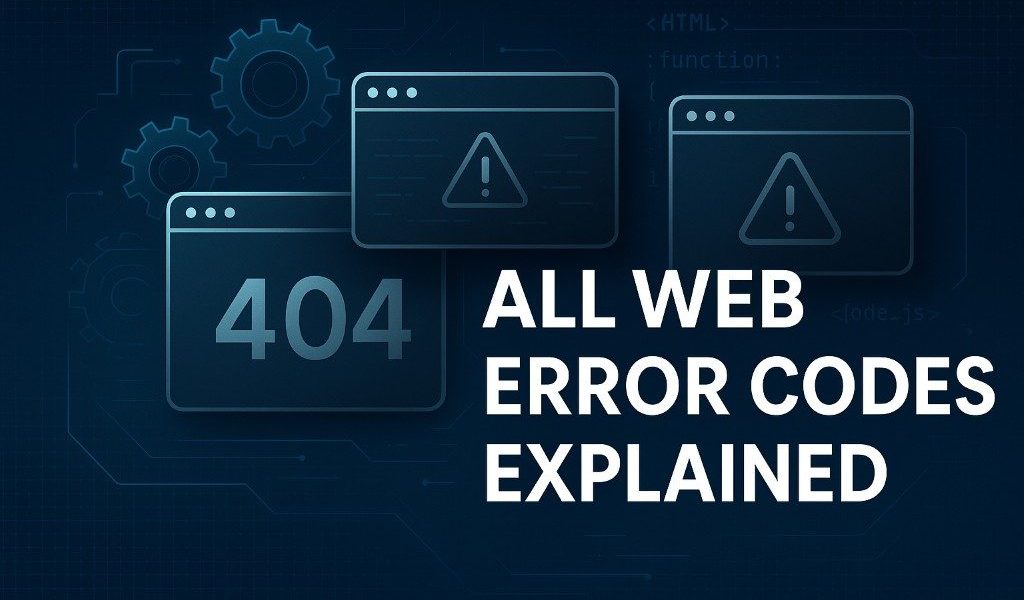📘 Introduction to Web Error Codes
Web error codes, also known as HTTP status codes, are the internet’s way of telling us what’s going on with a request made by a browser or client to a server. Whether you’re managing a website, developing software, or just trying to figure out why a link isn’t working, understanding these codes is essential.
These codes are grouped into five categories based on the first digit:
1xx – Informational
2xx – Success
3xx – Redirection
4xx – Client Errors
5xx – Server Errors
Let’s break each one down.
🟦 1xx Informational Response Codes
These indicate that the request was received and understood but not yet completed.
100 Continue
The server has received the request headers and the client should proceed to send the request body.
101 Switching Protocols
The server is switching protocols as requested by the client (e.g., HTTP to WebSockets).
102 Processing (WebDAV)
Acknowledges that the server has received and is processing the request, but no response is available yet.
✅ 2xx Success Codes
These mean the action requested by the client was received, understood, and accepted.
200 OK
The standard response for a successful HTTP request.
201 Created
The request has been fulfilled and has resulted in a new resource being created.
202 Accepted
The request has been accepted for processing, but the processing is not complete.
204 No Content
The server successfully processed the request, but there is no content to return.
🔁 3xx Redirection Codes
These indicate that further action is needed to complete the request.
301 Moved Permanently
The resource has been permanently moved to a new URL.
302 Found (Previously “Moved Temporarily”)
The resource resides temporarily under a different URL.
304 Not Modified
The resource has not been modified since the last request. Used for caching.
🚫 4xx Client Error Codes
These are errors on the client side, often due to a bad request or unauthorized access.
400 Bad Request
The server couldn’t understand the request due to invalid syntax.
401 Unauthorized
Authentication is needed to access the resource.
403 Forbidden
Access to the resource is denied.
404 Not Found
The server can’t find the requested resource.
405 Method Not Allowed
The request method is known but has been disabled for the target resource.
408 Request Timeout
The server timed out waiting for the request.
429 Too Many Requests
The user has sent too many requests in a given amount of time.
💥 5xx Server Error Codes
These mean the server failed to fulfil a valid request.
500 Internal Server Error
A generic error when the server fails unexpectedly.
501 Not Implemented
The server does not support the functionality required to fulfil the request.
502 Bad Gateway
The server received an invalid response from the upstream server.
503 Service Unavailable
The server is currently unavailable (overloaded or down for maintenance).
504 Gateway Timeout
The server didn’t receive a timely response from an upstream server.
🧠 Why Understanding These Codes Matters
Whether you’re troubleshooting a broken page, working on SEO, or just need to maintain a healthy web app, knowing these codes saves time and frustration. For instance:
404 errors can hurt your SEO ranking if left unchecked.
500 errors usually point to critical bugs that need fixing.
301 redirects are key in domain migrations and maintaining link juice.
🛠️ Tips to Handle Common Web Errors
Use tools like Google Search Console to identify 404s.
Check server logs for 5xx errors.
Implement proper redirect rules to handle 3xx codes efficiently.
Set up rate limiting and caching to avoid 429 and 504 errors.
🧾 Conclusion
HTTP status codes are more than just cryptic numbers. They’re essential indicators of what’s happening between your browser and the server. By understanding and managing these codes, you can significantly improve your site’s performance, reliability, and SEO.
Need help managing your website or fixing annoying HTTP errors? Get in touch with LuckyGene Indie Studios, and let’s get your web infrastructure running smoother than ever.


